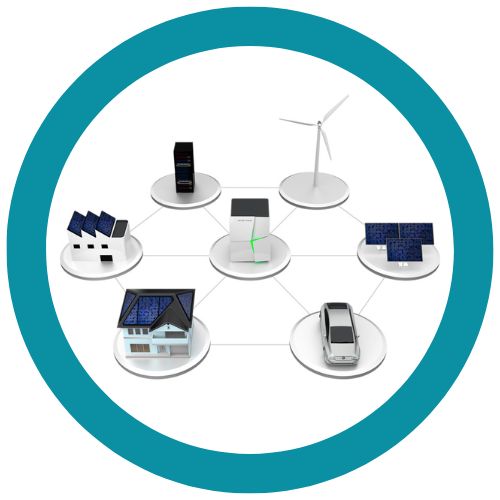It’s Electric! Innovative Energy Storage Systems for a Surging Market
The power of open innovation and breakthrough R&D are transforming the electric vehicle and energy storage sectors and can be the keys to a global clean energy movement. National policy changes, consumer demand, and improved efficiency in batteries are all factors supporting this market growth and opportunity for commercialization. Empower Ezassi’s open innovation consulting and technology scouting services to inspire the new energy initiatives your organization requires.
Electric Vehicle Supply & Equipment Technologies Require Innovative Ideas and Complex Collaborations Across Industries
As the world continues to move toward renewable sources of energy, vehicle manufacturers must also keep the pace with their technologies and corporate sustainability goals. The popularity of the electric car and the government incentives for transitioning from gas-powered vehicles are market trends that can’t be ignored in the energy sector.
Pew Research cites “two-thirds of Americans support providing incentives to increase the use of electric and hybrid vehicles.” But as the demand for electric cars accelerates, so too will the need for lithium, a crucial material used in its batteries. Storing electricity in a lithium-ion battery is an important part of the global mission to limit fossil fuels and combat climate change, so it’s no surprise the price of lithium has recently tripled. Aiming to source at least 40% of critical materials domestically, EV manufacturers must not only find new suppliers for this mineral but also identify startups focused on methods for recycling lithium.
Enhanced collaborations of leaders in EVSE (Electric Vehicle Supply Equipment: software, hardware, device enclosures, and plugs) with the mining industry, auto manufacturers, environmental services, and municipal governments are fundamental to continue to encourage adoption of these trending and beneficial technologies.
Repurposed Electric Car Batteries | Solar Powered Energy Storage Units
For now, there aren’t many EV batteries that need recycling. However, manufacturers are planning ahead and addressing circularity for used EV batteries. Transitioning away from traditionally fueled generators in areas where access to grid power is limited, Jaguar Land Rover Automotive, in partnership with Pramac’s power system company Off Grid Energy, has developed the technology to use discharged batteries from its I-PACE electric car to create a portable power station. With a goal to be carbon neutral by 2029, JLR created its gridtogo Battery Energy Storage System (ESS), a 125kW lithium-ion pack which is emission free, quiet, and can provide enough energy to power a family home for a week. As more customers turn to electric cars, this company has already looked at the innovative road ahead to drive sustainability of its used auto parts and bring additional value streams to its business.

Technology Horizon : New Materials are Reinventing Energy Storage Devices
It is predicted that by 2035, one trillion Internet of Things devices will require 109,000 tons of lithium and incalculable energy consumption needs. The innovation challenge should then be to design future power systems which support an expanding IoT world and that are constructed with more sustainable materials which also optimize functionality.
One potential innovative solution comes from research by the University of Cambridge Department of Biochemistry, who has designed a cyanobacteria “battery” using photosynthetic blue green algae to generate enough continuous power in a device about the size of an AA battery to run a microprocessor for six months. This photosynthetic device doesn’t drain power like a conventional battery because it’s continuously using light as an ongoing energy source. That’s a compelling current technology channeled by the power of nature!
Another advancement and R&D World award-winning innovation is Energy Inks. Next generation energy storage devices can be designed utilizing customizable, 3D direct printed inks. This transformative technology was developed through a collaboration between Lawrence Livermore National Laboratory, the University of California, Santa Cruz, and MilliporeSigma, an industrial chemical and materials supplier. Their energy ink contains high concentrations of graphene oxide, a material proven to maintain strong energy density and electric charge storage. For example, if a 3d-printed graphene aerogel electrode is fabricated for a supercapacitor, the device will be lighter, more efficient, and have a longer life expectancy. Due to applications in wind turbine power generation and regenerative braking technology in electric vehicles, the supercapacitor market is predicted to reach almost $17 billion by 2027. 3D printing the components of these products may be the key to scale production and improve functionality.
For an energy storage material that is fossil-free and bio-based, some innovators are looking to lignin, a sustainable byproduct of the paper industry. Stora Enso and Northvolt are partnering with Volvo and Polestar to use lignin as a substitute for carbon in battery anodes, thereby powering a future fleet of electric vehicles from green Nordic forest matter. Lignin may also have potential use for bio-fuels, thermoplastics, and as a replacement for crude oil-based substances.

For large scale commercial and industrial customers who are looking to new solutions that store and use energy sustainably and at lower cost consider Polyjoule, the Boston-based energy storage startup, which describes their approach to battery design as “contrarian,” using electrodes made of conductive polymers. Their energy storage core values include safety, sustainability, longevity, and affordability, and they believe they have the technology to pioneer a future of better electrification.
Other Innovative Ideas : Next Generation Structural Batteries & Mobile EV Charging
The EV options and designs that are in production today will certainly look very different in the near future. Improvements in battery technologies and materials will bring innovative disruption to this industry.
Breakthroughs in next generation structural batteries may soon allow all types of electronics to weigh less and be more compact. In a project collaboration between Sweden’s Chalmers University of Technology and KTH Royal Institute of Technology along with European Commission researchers and the US Airforce, a carbon fiber structural battery could potentially act as a “massless” energy storage solution for vehicles serving as a part of the load-bearing body structure. The latest prototype is ten times better for storage, stiffness, and strength demonstrating an emerging technology worth incorporating into the products of an innovation portfolio.
In the years ahead, electric car drivers can expect the parking and EV charging infrastructure to also change with the times. A concept from EV Safe Charge introduces, Ziggy, a mobile robotic EV charging robot with communication capabilities and built-in advertising, alerts a nearby driver of where to meet for a reserved spot to plug in for easy charging.
Refer to our previous article about clean power startups in the energy sector for more innovative solutions.
Power Open Innovation and Technology Scouting with Ezassi
Want to stay well connected to electric power storage? Take charge of your innovation portfolio through a strong Innovation Management Software platform. Your current innovation pipeline can be made more efficient utilizing our technology solutions: idea management and collaborative software with built in technology scouting tools.






